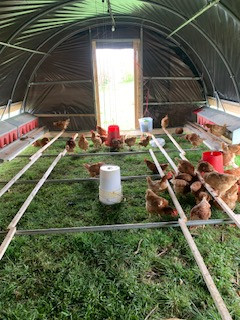How to Cook Grass‑Fed Steak So It Stays Melt‑In‑Your‑Mouth Tender
posted on
April 21, 2025
1. Start Cold? Nope—Start Dry
Take your steak out of the fridge and pat it bone‑dry with paper towels. Moisture on the surface turns to steam and blocks a crisp sear.
2. Season Early, Rest Longer
Salt draws moisture to the surface → moisture dissolves salt → steak re‑absorbs brine.
For grass‑fed, that process takes 45–60 minutes (vs. 30 minutes for grain‑fed). Season with kosher salt and cracked pepper, then let the steak sit at room temp until the exterior looks slightly tacky.
3. Use the Reverse‑Sear Method
-
Low & Slow – Preheat oven (or grill with indirect heat) to 250 °F. Place steak on a wire rack over a sheet pan and roast until it hits 115 °F internal (for medium‑rare finish).
-
Screaming‑Hot Sear – Move to a cast‑iron skillet or direct‑heat side of the grill at 500 °F+. Sear 45–60 seconds per side until a mahogany crust forms.
Why it works: gentle pre‑heat relaxes muscle fibers, then a fast sear locks juices in without overshooting your target temp.
4. Pull at 125 – 128 °F & Rest 10 Minutes
Grass‑fed’s lower fat marbling means it climbs in temperature a bit faster during carry‑over cooking. Pulling at 125 °F lands you right at a buttery 130–132 °F after the rest.
5. Slice Across the Grain
Look for the muscle fibers running the length of the steak and cut perpendicular to them. Shorter fibers = less chew. This is especially game‑changing for leaner cuts like Sirloin
6. Optional: Butter Baste for Extra Silkiness
During the sear, add 1 Tbsp. grass‑fed butter, a crushed garlic clove, and a sprig of thyme. Tilt the pan and spoon the foaming butter over the steak for 30 seconds per side. The fat fills in where intramuscular marbling would normally keep grain‑fed cuts juicy.
Quick Reference Chart
| Cut | Oven Temp / Time* | Sear Time | Pull Temp | Final Temp** |
|---|---|---|---|---|
| Ribeye (1¼ ") | 250 °F / ~20 min | 1 min/side | 128 °F | 132 °F |
| NY Strip (1 ") | 250 °F / ~18 min | 45 sec/side | 127 °F | 130 °F |
| Sirloin (1 ") | 250 °F / ~16 min | 45 sec/side | 126 °F | 129 °F |
| Filet (2 ") | 250 °F / ~25 min | 1 min/side | 125 °F | 128 °F |
*Times are guidelines—always trust your thermometer.
**After 10‑minute rest.
Final Bite
Cooked right, grass‑fed steak rewards you with a pure, clean, almost mineral sweetness you simply can’t find in grain‑finished beef. Follow the steps above, and you’ll never fear a “tough steak” again—just responsibly raised, Kentucky‑grown goodness on your plate.
Ready to practice? Stock up on your favorite cuts while they’re fresh in the freezer:
-
Shop all steaks →
Happy searing,
— Jud & the Cedar Valley Farms crew 🥩🔥






